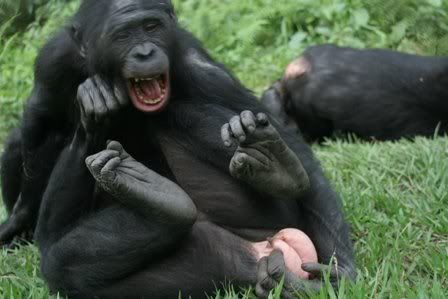Study suggests women display sexual cues during estrus

Lap dancers earn larger tips when men sense fertility
In my earlier post, Eye of the Beholder, I pointed to new research showing that women are most attracted to individuals other than their partners while in estrus, the most fertile period of a woman’s menstrual cycle. Their eyes betrayed their attraction to others even under controlled settings. Now it seems that estrus causes men’s eyes to widen as well.
Publishing in the journal Evolution and Human Behavior (pdf), evolutionary psychologists Geoffrey Miller, Joshua Tybur and Brent Jordan collected data on the tips received by lap dancers who were currently taking birth control and those who were naturally cycling. Those dancers who were at their most fertile period received significantly more tips than both dancers on birth control and those at other points in their cycle.
As the authors wrote in their study:
When women and men interact intimately over the course of several minutes through conversation and body contact, women apparently either “signal” or “leak” cues of their fertility status, and these cues influence spending patterns by male consumers. These results argue against the view that human estrus evolved to be lost or hidden from males.
However the study has several limitations, as the authors readily admit. The sample size included only 18 individuals which could result in “false positives,” or finding significant differences where there wouldn’t be in results from a larger population. Secondly, the tip earnings and cycle phase were self-reported by the dancers themselves. Knowing which phase of the cycle you’re in can be difficult to determine (or so I’ve been told) and any mistaken estimates are further compounded when the sample size is so small.
Nonetheless, it would be remarkable if women didn’t show some indications of their reproductive status during their peak of fertility. All female mammals display distinct behavioral and physiological cues during their fertile period that increase their reproductive success as a result. For example many primates, including our closely related chimpanzee and bonobo cousins, will develop large estrus swellings during their fertile period and will be more likely to approach the males they find desirable. Rhesus macaque females will vigorously court males during estrus, even using physical aggression if males reject their advances. Also, lionesses will actively seek out up to 100 matings per day with multiple individuals during their one-week of peak fertility (something that was edited out of The Lion King).

Image: Vanessa Woods
This study doesn’t suggest that the dancers were more attracted to their customers while in estrus (or attracted to them at all), merely that males could detect something irresistibly alluring, more so than during other times, and responded with their wallets.
Our society typically views women’s sexuality as either shameful or reserved for men’s enjoyment (as I’m sure the women in this study know all too well). However, in an ironic twist, this tentative evidence of estrus signaling among lap dancers emphasizes the personal empowerment inherent in the evolution of female sexuality. For thousands of generations those women who displayed a healthy sexual desire during their most fertile period were ultimately more successful in the evolutionary dance. This legacy remains visible today, even in women who want nothing more from the males in their vicinity than a decent tip.
Reference:
Geoffrey Miller, Joshua M. Tybur, Brent D. Jordan (2007). Ovulatory cycle effects on tip earnings by lap dancers: economic evidence for human estrus? Evolution and Human Behavior. doi:10.1016/j.evolhumbehav.2007.06.002




















5 comments:
I realize I'm a bit behind in commenting on this (yet I'm the first?), but the way this "study" has been reported is an example of the kind of science writing that makes me want to scream. I don't know how often, in popular magazine articles, or mainstream media "science" articles, what gets trumpeted over and over again is supposed scientific "evidence" for a simplistic, "we're all just animals" explanation of male-female behavior that more often than not leads to the conclusion that the objectification of women is just "hard-wired," or ridiculously overemphasizing women's reproductive biology and its role. The role of "pheromones" is tossed around in an inaccurate and sensationalistic way, and more often than not these articles chalk up phenomenon such as judging women based on their looks as just "hard wiring" and due to the human reproductive drive asserting itself.
(Even scientifically trained writers, such as Barbara Kingsolver, who writes regularly for scientific journals and has a biology degree herself, loves to throw ridiculous examples into her fiction: a woman who "turned men's heads on the street, one after another, in the middle day of her cycle," or "No wonder they were fluttering around her like moths. She was ovulating." There's an attempt to explain complex human behavior by likening it to non-human primate behavior, with no accounting for things like independent will or social conditioning or consciousness or anything else.) And it's not just the implications of this that bug me, though the implications are horrid -- taken to its logical conclusion, the "we're all just animals" theme has been used to justify rape as a male's attempt to pass on his sperm -- but the shoddy and mechanical methodology, and the way that this filters down to readers and the general public in such a way as to actually justify a lot of oppressive social relations.
Or the question of why humans are the only primates (do I have that right??) who don't have a visual estrus period; it's really fascinating and complex, but how much of the writing and research is filtered through the assumption that humans have always existed in monogamous, heterosexual, family units? (FYI, do you know of literature that does wrestle with the evolutionary implications of this expression, or lack thereof, of estrus in humans?)
Anyway, this comment grew longer than I intended, but it's a thing I've been thinking about lately, and one of the things that I, as a person with no actual formal training in science beyond a single Physical Anthropology class, love coming to ScienceBlogs, and the like, for.
Linda,
Thank you for that comment and I agree with your concerns. Given our long history of using "science" to justify the exploitation and/or objectification of women, scientists and science writers alike need to be mindful of how they're choosing and communicating research about female sexuality. If I have failed to properly communicate this then I apologize. This study does not suggest that, if women do advertise their fertility (and this study has several problems as I identified), that it is therefore acceptable to regard women as reproductive objects that have no independent agency.
As I wrote earlier in my post The Origins of Forbidden Love, female sexual behavior is as much a product of social influences as it is biological (but also see The Evolution of Menopause for an example of how biology influences social behavior). I don't think there's any denying that there are commonalities between humans and other animals (I study primate behavior and can go on at length about such similarities if you like). But to underemphasize individual agency misses the larger picture (I think it does with other animals as well, but that's another issue).
An example that I think is germane is that of infanticide. Immigrant primate males (including chimpanzees and gorillas) will sometimes kill infants in their troop once they achieve alpha position. Primatologist Sarah Blaffer Hrdy (author of one of my favorite books Mother Nature: Maternal Instincts and How They Shape the Human Species) has shown that by killing the infants that are unrelated to him, the females in the troop soon go back into estrus and will mate with him, thus passing on more copies of that infanticidal male's genes. This horrific act is a successful strategy in male reproductive success (although females in these species have a host of counter-strategies, including working together to attack the male). In humans we find that frequencies of infant abuse and infanticide are highest when a step-father is in the house (for more on this see this article in Discover magazine). However, just because infanticide may be “natural” doesn’t mean that we should therefore accept it. Like trying to understand the mind of a psychopath, by understanding why infanticide occurs and when it’s more likely to occur, we can more effectively plan strategies to prevent it. A similar case can be made for rape. Males of other species sometimes force females to mate with them (occasionally it’s the other way around, but not very often). This shouldn’t justify rape in humans any more than infanticide should be justified. But by understanding the biological influences involved it can better inform our policy decisions (for example, I think rape should be considered a hate crime domestically and when committed in battlezones should be punished as a war crime according to the Geneva Conventions).
As for your question about humans being the only primates with concealed estrus, there are many other primates that don’t have obvious visual signs. Primates are unique among mammals in this regard. Examples include orangutans, howler monkeys, marmosets, most macaque species and many more. Jared Diamond wrote an article on this topic for Discover magazine that you can read here. Marmosets, for example, mate at all times during their cycle but show the highest frequencies during their 11-day period of peak fertility, suggesting that either the females feel more like mating or the males can tell they’re ovulating (see this paper in Folia Primatolgica). This study with lap dancers suggests something very similar. It's unknown if the dancers themselves just "felt" sexier and were able to earn larger tips or if the males could sense the women's fertility (my guess would be the former).
Likewise, monogamy isn't the norm for primates nor even is it the most common mating system in humans (I discuss some of this in The Origins of Forbidden Love). Heterosexual mating is the most common practice but there are numerous non-human and human non-Western examples of homosexual partnerships (see Joan Roughgarden's book Evolution's Rainbow: Diversity, Gender and Sexuality in Nature and People).
I hope that addresses your questions and concerns. Please feel free to ask me any additional questions you like (and please continue to challenge how studies on these topics are communicated).
Eric,
thanks for the long and thoughtful reply. I just found this blog, so I'm going to catch up, with the posts you linked to and others.
I think, re-reading my own comment, that I had some problems with tone (and with method) myself. I didn't mean to accuse you of justifying the objectification of women, or oppressive social relations, in how you yourself wrote up this study; my tone was much more meant in the spirit of friendly conversation and debate. Which is related to another methodological problem of mine, exemplified here: "There's an attempt to explain complex human behavior by likening it to non-human primate behavior, with no accounting for things like independent will or social conditioning or consciousness or anything else.)"
I think that it's valid to criticize the above-characterized method for its reductivity, its lack of complexity, its unspoken assumptions, etc. And I do think it should be said that such methodological problems are seriously harming a deeper and richer understanding of human behavior. (Or, as you pointed out, non-human behavior too.)
But I have to confront that part of what bothers me (and this affected the tone I used) is that it ignores or downplays the role of human consciousness and independent will. Is that a valid methodological criticism to make? It's valid to make criticisms of method (and therefore at the results that can be drawn) but not valid to have an a priorist assumption that human will and consciousness plays X role in human social behavior, and therefore studies that seem to cast doubt on that are wrong. I don't think that this is a settled question.
It's wrong to make a criticism of an article, a study, etc, much less an entire method, because one don't like its implications.
Does that make sense?
I come at this as a person who thinks that human consciousness and independent will are tremendously important in understanding human behavior, and that people act in ways that are historically determined -- that even individual will and consciousness are effected by so many factors, overwhemingly social and historical factors -- and that because humans have such an advanced level of consciousness, that attempts to explain complex human behavior in simplistic "we're all animals" (is there a better term for that phrase?) fall short. But as I said above, there's still much to be learned about the role of social factors, economic factors, and, yes, human will and consciousness, and the fact that all of this happens in populations but that people are people, and individuals -- not merely one of a larger group or group dynamic. And people are complicated.
Anyway, I find this entire line of inquiry fascinating and challenging -- and it's also got tremendous implications (there's that word again) for understanding, much less changing, human social behavior, especially truly harmful behavior.
I'll check out those other readings with interest.
This comment (once again) is a lot longer than I intended it to be (and you should see what I deleted!), so I'll close by saying I appreciate, and really agree with, this comment:
"But to underemphasize individual agency misses the larger picture (I think it does with other animals as well, but that's another issue)."
and also this: "This study does not suggest that, if women do advertise their fertility ... that it is therefore acceptable to regard women as reproductive objects that have no independent agency."
Quite so.
A propos (sp?) of our discussion, I found this pretty funny piece via Amptoons:
"Belief in Evolutionary Psychology May Be Hardwired, Study Says
Biologists have long assumed that evolutionary psychology, a controversial branch of psychology that ascribes many common social behaviors to genetics, is a muddled blend of half-understood evolutionary biology, selective data mining and resentment of women’s changing roles in society.
(...)
Believers in evolutionary psychology maintain that feminism sets itself in opposition to millions of years of anthropoid evolution, and is thus futile and inhumane to men. Allegations made by believers include references to putative differences in math skills between men and women, a supposedly irresistible but entirely non-visually stimulated female attraction toward powerful and/or arrogant males, and the existence of a genetically preordained male right to multiple female sexual partners.
Many such men hold to these beliefs despite an absolute lack of supporting scientific evidence, says Dr. Ulrike Mann-Esser, chair of the sexual anthropology department at Universität Ulm and the study’s lead researcher. “But we had no way to determine why this was so until last year’s discovery of the locus taedius.”
Saying something "makes me want to scream" implies you are angry. Getting angry when someone expresses an opinion you dislike is usually not healthy for you or society.
The only exception that comes to mind would be inciting violence/hatred.
I believe evolutionary psychology is a very helpful in understanding human behavior. The more we understand, the less we fear.
Post a Comment